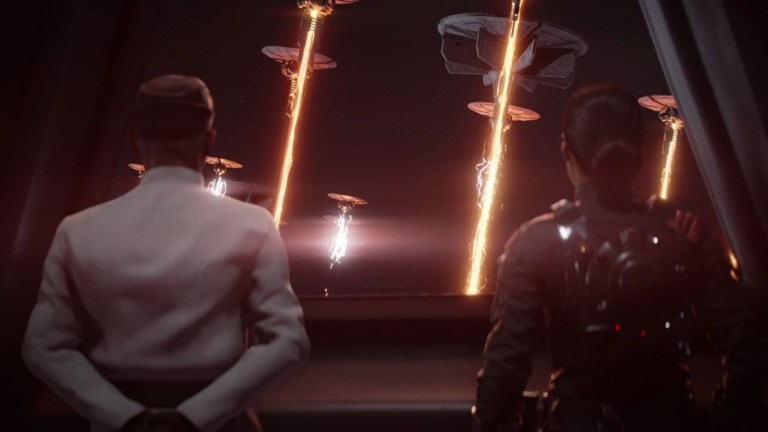The Mandalorian: Operation Cinder Explained
Does the Operation: Cinder reference in The Mandalorian episode "The Believer" mean that Iden Versio is coming to the live-action series?

This Star Wars: The Mandalorian article contains spoilers.
The Galactic Empire has fallen by the time of The Mandalorian, but the Imperial remnant left in its wake has plenty of fight left. Mercenary Mayfeld (Bill Burr) shed light on one of the remnant’s earliest offensives against the New Republic when he mentioned participating in Operation: Cinder in “The Believer.”
Fans of the Star Wars Expanded Universe of books, comics, and games likely jumped at the reference. After all, Operation: Cinder effectively connects the Disney+ series to several other stories that go all the way back to the beginning of the canon reset. So what is Operation: Cinder and why is it important?
What is Operation: Cinder?
Fire rains down on peaceful planets. Even without the Death Star, the Empire’s remaining military might means it can ravage a planet’s surface so thoroughly that the planet might as well have been destroyed.
The Empire executed Operation: Cinder by planting a series of satellites in a planet’s orbit, forming a “climate disruption array” designed to spark disastrous weather effects on the planet’s surface. Electrical and fire storms and hurricanes ravaged these planets, while Star Destroyers and TIE fighters kept ships from leaving the planet and the New Republic forces from interfering.
The events of Operation: Cinder, which took place right after the Battle of Endor, were first explored in the Shattered Empire comic book miniseries by Greg Ruck and Marco Checchetto. In that comic, Leia had to stop Cinder from destroying Naboo. Meanwhile, in Star Wars Battlefront II, Inferno Squad trooper Iden Versio defected from the Empire after it used Cinder to destroy an allied planet, the “Imperial utopia” of Vardos.
In “The Believer,” Mayfeld recounts a very similar situation to the one in Battlefront II. Mayfeld describes how the Empire struck the surface of Burnin Konn without prejudice, killing thousands of its own soldiers in the process. It’s implied that this betrayal is what convinced Mayfeld to leave his life as an Imperial sharpshooter behind. It’s also why he has no problem blasting his former Imperial officer, Valin Hess (Richard Brake).
Other planets targeted by the Empire included Candovant, Abednedo, Commenor, Senthrodys, and Nacronis.
Why was Operation: Cinder Created?
After the death of Emperor Palpatine in Return of the Jedi, an automated message was sent across the stars, putting the operation in motion. Specifically, the order was conveyed by Palpatine’s messenger droids, creepy red-robed robots with a hologram of Palpatine’s face emanating from their heads. (In the years after the fall of the Empire these droids became objects of fascination and even worship among the Imperial remnant.)
Operation: Cinder was part of Palpatine’s contingency plan in the event of his death. It was designed as the first step of his ultimate goal: to return with the Final Order and the Sith Eternal in The Rise of Skywalker after finding a new Force-sensitive host to possess.
With Cinder, Palpatine wanted to continue spreading fear in the galaxy and to show that nowhere was safe from the Empire. The final step of this contingency plan was supposed to be the destruction of both Imperial and Republic fleets. This failed, as demonstrated in the Aftermath trilogy of novels.
But why destroy the Empire he worked so hard to build throughout his life? Palpatine didn’t want the Empire to live on without him or for someone else to rule in his place. He believed that the destruction of the Empire would allow it to be reborn in the Unknown Regions (the uncharted part of the Star Wars galaxy where Exegol is located) when the time was right. This eventually came to pass when the First Order returned to destroy the New Republic 30 years after his death.
What Does Cinder Mean for The Mandalorian?
Valin Hess’ toast to Operation: Cinder is a sinister acknowledgement that he’s one of the people who was perfectly fine with the mass killings, solidifying his brief role as a monstrous villains. Besides the destruction of Alderaan, Operation: Cinder is about as bad as it gets when it comes to the pure scale of the atrocities committed by the Empire, and it makes sense that the effects of the operation are still felt just five years after Return of the Jedi.
Operation: Cinder shows the depravity of the Empire even after the Rebellion’s victory. The Mandalorian‘s brief mention of it was a smart way to show how, even though he’s dead, the Emperor still has a long reach when it comes to hurting people no matter what side of the war they stand on.
Some fans have wondered if the reference to Cinder could also mean that some of the other characters tied to the event could now make their way to the show, namely Iden Versio herself. Played by Janina Gavankar, the character would be an interesting addition to the show, even if it were just for an episode. At the point when The Mandalorian takes place, Versio would already be working for the New Republic, and she’d undoubtedly have some valuable insight about Moff Gideon and the Imperial remnant that could help Mando in his fight to protect Grogu.
Whatever may happen next, the Operation: Cinder reference is yet another example of the level of synergy the show has with the other parts of the Expanded Universe. Disney and Lucasfilm want canon to feel like a living, breathing story, and including weighty references like this one is a good way to do it.
Keep up with all of The Mandalorian season 2 news here.

